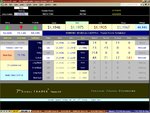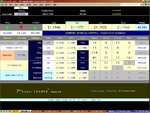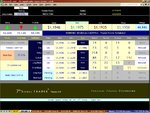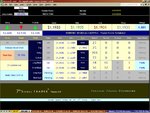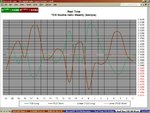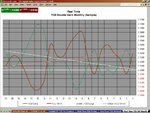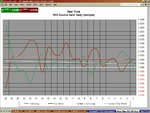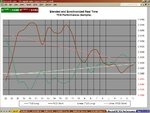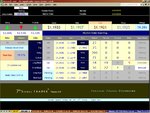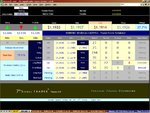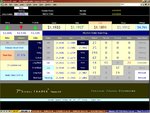soccer_daemon said:
Hi 7th,
While the TCD charts show the EUR bottoming during last week, but I suspect
you won't trade on that basis alone with the look and feel of the TCD, right ?
There is always a "possibility" that the bottoming is not yet done and it may turn
up, bounce off the zero line and continue further down, that's the TCD Long I
am refering to. I guess that is where your predictive module comes into the
play and make a quantifiable prediction. Also, to do this sort of statistical
analysis, will it make more sense to have deltas measured in %change instead
of pip-change ?
My pivot for 20/02/2006 (TZ: GMT+11):
pivot: 1.1945 <----- got the wrong value before, this is the one for 20/02/2006.
H: 1.1984
L: 1.1894
Thanks
SD
ps: One more question, sorry about that. Did u ever have observation of
"divergence" on TCD chart when overlayed on to price chart ? 😎)
If you want more refinement you can use percentage change – I do. In some placed within the Engine, I don’t need that level of refinement, but when I’m using Daily data, for example, I’ll more times than not use % change in many of my calculations for better approximation and a tighter overall system. It is up to the designer, really.
As far as convergence is concerned, yes – it happens all the time – as well it should. The Real-Time TCD’s should be slightly ahead of traditional price charts, but not too far out in front. Of course, this is where some of the Predictive nature of the system comes from. Take a look at these updated Real-Time TCD charts and then go back and study conventional price charts for the past 6 days (which will include that last session). On the Daily Charts, positions 1 – 6 covers the past 6 days of activity.
Notice that on the Blended chart, the green line is now showing that it crossed over the red on position 5 (5 trading days ago). Well, go back and look at any Daily price chart – what do you see? Basically, a bottoming-out of the EURUSD’s short-term price action before last Friday’s move up which was being projected by the system with its “Day Trade” signal Long calls most of last week. Then take a look at the Daily chart at the same position 5 (5 trading days ago). That chart shows that up until that point, the Short TCD’s were in charge – with the most recent
negative TCD being the “Long” at position 8. Now, take a look at the Weekly chart. Look at position number 2 (last weeks trading activity). You can now see the result of that “Pincer” move that I spoke about last week where the Short was pointing down towards the zero line steeply and the Long was pointing up to the zero line from
underneath it. Both converging on each other having slammed into each other at the start of this weeks trading activity.
Now, the thing to keep in mind here is that these are
not price charts! (sometimes when I am doing my visual research and analysis, I have to remind myself of that fact, or even I sometimes get confused)
So, you could very well “see” a green line over a red line, but when you look at the price action for a given session you might notice the price going “down” – not up. These charts are not always indicators of where the price
moving at this very minute. Rather, these charts are better indications of where the
”next” large move is most likely to come from. I don’t make decisions based on these charts, but they do help me visualize – or get a
feel for where the “next” move is likely to come from. So, from a purely psychological standpoint, I can use these analog charts along with the digital information coming from the Dashboard and “feel” more confident about the “next” move being displayed on the Panel.
Knowing that RT TCD’s do not like to remain under water, helps me understand where the “next” big move needs to come from in order to maintain the systems Price Structure. If you notice carefully, you will see that the Daily TCD’s do not get as negative as the Weekly and the Weekly does not get as negative as the Monthly. So, if I get a Daily Long TCD (for example) that goes negative – that does not always mean that the very next move is Long. But, when I get a Daily Long TCD going negative inside a Weekly Long TCD that is positive and stronger than the Weekly Short TCD, then that tells me that the “next” move typically within the next 24-48 hours should be Long. The inverse is typically true as well.
(see new pics of TCD charts below)
Hope that helps.

